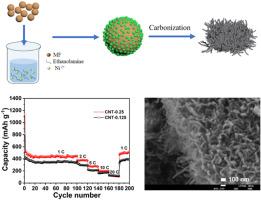Facile synthesis of carbon particles composed of N-doped carbon nanotube and their application in lithium-ion batteries
IF 4.3
3区 材料科学
Q2 CHEMISTRY, MULTIDISCIPLINARY
引用次数: 0
Abstract
The synthesis of N-doped carbon materials plays an important role in improving electrochemical performance for lithium-ion batteries. The synthesis of N-doped carbon materials with special morphology and structure remains a challenge, because it is difficult to achieve both goals simultaneously. Carbon particles composed of N-doped carbon nanotubes have been successfully prepared via a simple method using Ni2+ salt, melamine-formaldehyde resin microspheres and ethanolamine as the raw materials. The as-synthesized carbon particles possess a stable reversible capacity of 445.5 mAh g−1 at 1 C after 100 cycles. Even at 10 C and 20 C, the reversible capacities could also reach 200.1 and 109.8 mAh g−1. The excellent electrochemical performance of the carbon particles can be attributed to both unique structure and N-doping. The high surface area and long carbon nanotube can provide more active area and facilitate the electron transport. Moreover, N-doping can increase the electrical conductivity and create the defects for carbon materials, which are favorable for Li+ adsorption.

N 掺杂碳纳米管组成的碳颗粒的简便合成及其在锂离子电池中的应用
掺氮碳材料的合成在提高锂离子电池的电化学性能方面发挥着重要作用。合成具有特殊形态和结构的掺 N 碳材料仍然是一项挑战,因为很难同时实现这两个目标。以 Ni2+ 盐、三聚氰胺甲醛树脂微球和乙醇胺为原料,通过简单的方法成功制备了由掺杂 N 的碳纳米管组成的碳颗粒。合成的碳颗粒在 1 C 条件下循环 100 次后,其可逆容量稳定在 445.5 mAh g-1。即使在 10 C 和 20 C 条件下,可逆容量也能达到 200.1 和 109.8 mAh g-1。碳颗粒优异的电化学性能得益于其独特的结构和 N 掺杂。高比表面积和长碳纳米管可以提供更多的活性面积,促进电子传输。此外,掺杂 N 还能提高导电性,并为碳材料创造有利于吸附 Li+ 的缺陷。
本文章由计算机程序翻译,如有差异,请以英文原文为准。
求助全文
约1分钟内获得全文
求助全文
来源期刊
CiteScore
7.80
自引率
2.50%
发文量
605
审稿时长
40 days
期刊介绍:
The Journal of Physics and Chemistry of Solids is a well-established international medium for publication of archival research in condensed matter and materials sciences. Areas of interest broadly include experimental and theoretical research on electronic, magnetic, spectroscopic and structural properties as well as the statistical mechanics and thermodynamics of materials. The focus is on gaining physical and chemical insight into the properties and potential applications of condensed matter systems.
Within the broad scope of the journal, beyond regular contributions, the editors have identified submissions in the following areas of physics and chemistry of solids to be of special current interest to the journal:
Low-dimensional systems
Exotic states of quantum electron matter including topological phases
Energy conversion and storage
Interfaces, nanoparticles and catalysts.

 求助内容:
求助内容: 应助结果提醒方式:
应助结果提醒方式:


